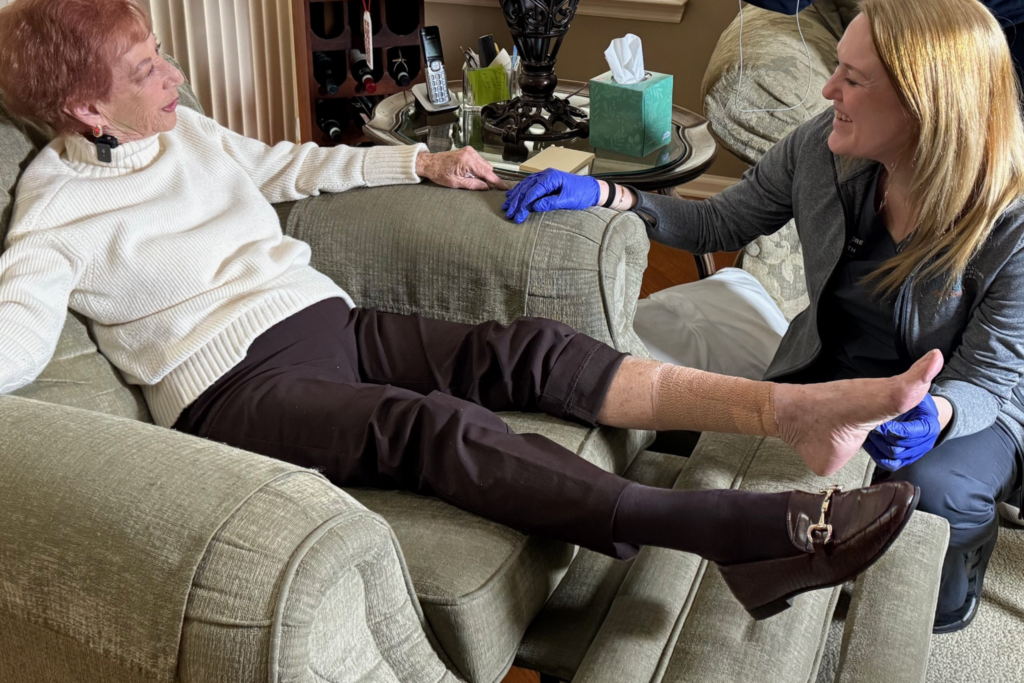Venous leg ulcers (VLUs) are a common yet serious condition that can impact a person’s quality of life, leading to pain, immobility, and increased risk of infection. At Restore First Health, we specialize in advanced mobile wound care, ensuring patients receive the most effective treatments in the place they call home.
What Are Venous Leg Ulcers?
Venous leg ulcers are chronic wounds that develop due to poor circulation in the lower legs. It is the most common type of chronic leg wound, accounting for 70%-90% of all lower leg ulcers and it typically occurs above the ankle.
What Causes Venous Leg Ulcers?
VLUs develop due to chronic venous insufficiency (CVI), a condition where the veins in the legs fail to efficiently return blood to the heart. When this happens, blood pools in the veins, increasing pressure and leading to skin damage. Over time, this pressure can cause the skin to break down, forming an ulcer.
Several risk factors contribute to VLUs, including:
- A history of deep vein thrombosis (DVT): Blood clots can damage vein valves, leading to chronic venous disease.
- Varicose veins: Dysfunctional valves allow blood to pool in the veins, increasing venous pressure.
- Obesity: Excess weight places additional strain on the veins.
- Immobility: Prolonged sitting or standing can impair circulation.
Read: How To Improve Circulation to Promote Wound Healing
- Older age: Aging leads to decreased vein elasticity and function.
- Diabetes: Impaired circulation and delayed wound healing increase ulcer risk.
Signs and Symptoms
Patients with VLUs may experience:
- Pain or aching in the legs (often relieved by elevation).
- Swelling (edema) in the lower legs.
- Skin changes, including darkening, thickening, or hardening.
- Open sores with irregular edges, typically located near the ankles.
- Itching or burning sensations.
- Yellowish or greenish discharge, which may indicate an infection.
Preventing Venous Leg Ulcers
Here are 4 ways to prevention VLU’s:
- Wearing compression stockings daily.
- Elevating the legs regularly to improve circulation.
Read: 5 Essential Tips for Staying Active with Wound Care
- Maintaining a healthy weight.
- Keeping skin moisturized.
Why Choose Restore First Health for VLU Care?
At Restore First Health, we offer a patient-centered, mobile approach to wound care. Venous leg ulcers are a serious medical condition that requires expert care and intervention. With the right treatment and preventive measures, patients can achieve significant healing and avoid future complications. Our team of advanced practitioners provides at-home evaluations, personalized treatment plans, and state-of-the-art wound healing therapies.
Need expert wound care? Schedule an appointment with Restore First Health today!
Follow us to keep up to date with the latest health news:
1. **Alavi, A., et al. (2021).** “Approach to Venous Leg Ulcers.” *Journal of Clinical Medicine*, 12(17), 5605. Retrieved from: [https://www.mdpi.com/2077-0383/12/17/5605](https://www.mdpi.com/2077-0383/12/17/5605)
2. **O’Donnell, T. F., & Passman, M. A. (2020).** “Venous Ulcers: Diagnosis and Management.” *StatPearls Publishing*. Retrieved from: [https://www.ncbi.nlm.nih.gov/books/NBK567802/](https://www.ncbi.nlm.nih.gov/books/NBK567802/)
3. **Snyder, R. J., et al. (2021).** “Venous Leg Ulcer Care: Clinical Recommendations and Pathways.” *Advances in Skin & Wound Care*, 34(8), 409-421. Retrieved from: [https://www.sciencedirect.com/science/article/pii/S0890509621005021](https://www.sciencedirect.com/science/article/pii/S0890509621005021)
4. **Serena, T. E., et al. (2021).** “Venous Leg Ulcers: A Review of the Pathophysiology and Current Treatment Options.” *PMC7950183*. Retrieved from: [https://pmc.ncbi.nlm.nih.gov/articles/PMC7950183/](https://pmc.ncbi.nlm.nih.gov/articles/PMC7950183/)
